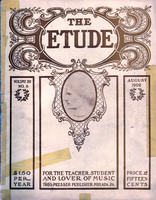Selected Content from the August 1902 Edition of The Etude
Now let us see by what an absurdly simple process of reasoning Mrs. X possessed herself of the knowledge that her fiddle is a genuine Stradivarius. Read More
A correspondent asks me to explain the apparent inconsistencies in the employment of the staccato sign, and lays some stress on the fact that many admirable violinists either disregard the sign altogether or give it a musical meaning differing from… Read More
No study could be better calculated to develop strength and independence of the forearm and wrist than the eighth Caprice. It should be played in the upper quarter of the bow, and in the following manner: The upper arm should… Read More
Fernand de la Tombelle’s compositions include several suites and other orchestral pieces, chamber-music (quartets and trios for strings or for piano and strings), choral scenes, sets of songs, and numerous organ-compositions, including two sonatas. Read More
Chorus singing, with a strong, rich organ support, is inspiring and effective; but if heard in much the same amount, power, and with about the same character, throughout an entire service and Sunday after Sunday, interest is lost. We cannot appreciate the value of music which never varies. We want contrast. Read More
From an etymological point of view it is, however, quite easy to account for the word “stop.” Until about the middle of the fifteenth century each key in an organ controlled a certain pre-arranged number of pipes; in fact, the organ was simply a huge “mixture,” sometimes having forty or fifty ranks. When means were devised by which the player could stop certain ranks from sounding, thus isolating others he wished to use alone, a new era dawned in the annals of organ-building. Read More
Methinks that organists are not really aware of their responsibilities and their true position in relation to the public. The possibilities arising out of influences exerted by them might be immense, and material assistance rendered toward bringing about a better and thorough understanding of all that pertains to our “divine art.” Read More
Occasionally one meets an organist who prefers a low shoe, and I once met an organist (?) who “could not play” unless he wore his patent-leather slippers. The objection to slippers and an objection to low shoes, though less in the case of the latter, is that they slip at the heal. Read More
A four-manual organ having 65 speaking stops has recently been placed in the Grace Church, Chicago, by the Kimball Organ Company. The great organ contains 15 stops, the swell organ 17 stops, the choir organ 11 stops, the solo organ 6 stops, the echo organ 4 stops, and the pedal organ 10 stops. The organ contains 27 combination pistons. The opening recital was given by Mr. Harrison M. Wild, of Chicago. Read More
Raoul Pugno, the French pianist, is to make a concert-tour in the United States next season. Read More




